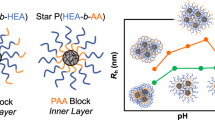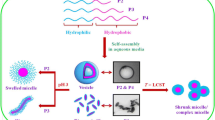Abstract
Multi-arm block copolymers with stimuli-responsive behavior are a potential candidate in the field of nanoscience and nanotechnology due to their unique design, specific property-regulating ability and appealing applications. Here, tri-arm star diblock copolymers, poly(2-hydroxyethylacrylamide)-block-poly(N-isopropylacrylamide), P(HEAAm–b–NIPAAm) consisting of PHEAAm and PNIPAAm as inner and outer blocks were synthesized via two-step ATRP. The synthesized polymers were characterized using ATR-IR, 1H-NMR and GPC techniques. It is revealed that introducing a higher number repeating units (300) of HEAAm into copolymers could facilitate the formation of micelles in the cross-linked points and the occurrence of phase transition at higher temperatures. DLS measurements prove that tri-arm block copolymer with the lower number repeating units (50) of HEAAm core could not prevent random aggregation, whereas longer PHEAAm300 core produces ca. 200 nm aggregate steadily at the adjoining knot at above LCST. Lowering of UV–Vis absorbance at 40 °C proved the entrapment of Rhodamin B into PNIPAAm300 aggregates. Atomic force microscopy image of P(HEAAm300–b–NIPAAm21) shows a loop (network structure) with the terminal PNIPAAm consistent aggregate size ca. 237 ± 42 nm.
Graphical abstract
(A) Schematic chemical structure of tri-arm poly(HEAAm-b-NIPAAm) diblock copolymer, (B) AFM image of nanoparticles formation, (C) nanoparticles distribution in aqueous solution at 34 °C (LCST) and at 50 °C, and (D) aggregation and expansion mechanism










Similar content being viewed by others
References
Parlok O, Ashaduzzaman M, Kollipara SB, Tiwari A, Turner APF (2015) Switchable bioelectrocatalysis controlled by dual stimuli responsible polymeric interface. ACS Appl Mater Interfaces 7:23837–23847. https://doi.org/10.1021/acsami.5b06048
Mishra S, Ashaduzzaman M, Mishra P, Swart HC, Turner APF, Tiwari A (2017) Stimuli-enabled zipper-like grapheme interface for auto-switchable bioelectronics. Biosens Bioelectron 89:305–311. https://doi.org/10.1016/j.bios.2016.03.052
Dutta K, De S (2017) Smart responsive materials for water purification: an overview. J Mater Chem A 5:22095–22112. https://doi.org/10.1039/C7TA07054C
Huang H, Qi X, Chen Y, Wu Z (2019) Thermosensitive hydrogels for delivering biotherapeutic molecules: a review. Saudi Pharm J 27:990–999. https://doi.org/10.1016/j.jsps.2019.08.001
Zhang X, Shen W, Dou J, Meng Y, Fang S, Liu R (2019) Enhanced mechanical properties and self-healing behavior of PNIPAM nanocomposite hydrogels by using POSS as a physical crosslinker. J Appl Polym Sci 137:48486. https://doi.org/10.1002/app.48486
Huang Z-S, Shiu J-W, Way T-F, Rwei S-P (2019) A thermo-responsive random copolymer of poly(NIPAm-co-FMA) for smart textile applications. Polymer 184:121917. https://doi.org/10.1016/j.polymer.2019.121917
Elella MHA, Aamer N, Mohamed YMA, Nazer HAE, Mohamed RR (2022) Innovation of high-performance adsorbent based on modified gelatin for wastewater treatment. Polym Bull. https://doi.org/10.1007/s00289-022-04079-4
Elella MHA, Shalan AE, Sabaa MW, Mohamed RR (2022) One-pot green synthesis of antimicrobial chitosan derivative nanocomposites to control foodborne pathogens. RSC Adv 12:1095–1104. https://doi.org/10.1039/D1RA07070C
Abu-Thabit NY, Uwaezuoke OJ, Elella MHA (2022) Superhydrophobic nanohybrid sponges for separation of oil/water mixtures. Chemosphere 294:133644. https://doi.org/10.1016/j.chemosphere.2022.133644
Goda ES, Elella MHA, Hong SE, Pandit B, Yoon KR, Gamal H (2021) Smart flame retardant coating containing carboxymethyl chitosan nanoparticles decorated graphene for obtaining multifunctional textiles. Cellulose 28:5087–5105. https://doi.org/10.1007/s10570-021-03833-7
Elella MHA, Goda ES, Yoon KR, Hong SE, Morsy MS, Sadak RA, Gamal H (2021) Novel vapor polymerization for integrating flame retardant textile with multifunctional properties. Compos Commun 24:100614. https://doi.org/10.1016/j.coco.2020.100614
Elella MHA, Goda ES, Gab-Allah MA, Hong SE, Pandit B, Lee S, Gamal H, Rehman AU, Yoon KR (2021) Xanthan gum-derived materials for applications in environment and eco-friendly materials: a review. J Environ Chem Eng 9:104702. https://doi.org/10.1016/j.jece.2020.104702
Pandit B, Goda ES, Elella MHA, Rehman AU, Hong SE, Rondiya SR, Barkataki P, Shaikh SF, Al-Enizi AM, El-Bahy SM, Yoon KR (2022) One-pot hydrothermal preparation of hierarchical manganese oxide nanorods for high-performance symmetric supercapacitors. J Energy Chem 65:116–126. https://doi.org/10.1016/j.jechem.2021.05.028
Kotsuchibashi Y, Yamamoto K, Aoyagi T (2009) Assembly behavior of double thermo-responsive block copolymers with controlled response temperature in aqueous solution. J Colloid Interface Sci 336:67–72. https://doi.org/10.1016/j.jcis.2009.03.093
Chen Y, Sone M, Fuchise K, Sakai R, Kakuchi R, Duan Q, Sun J, Narumi A, Satoh T, Kakuchi T (2009) Structural effect of a series of block copolymers consisting of poly(N-isopropylacrylamide) and poly(N-hydroxyethylacrylamide) on thermoresponsive behavior. React Funct Polym 69:463–469. https://doi.org/10.1016/j.reactfunctpolym.2008.12.016
Cao Z, Liu W, Ye G, Zhao X, Lin X, Gao P, Yao K (2006) N-isopropylacrylamide/2-hydroxyethyl methacrylate star diblock copolymers: synthesis and thermoresponsive behavior. Macromol Chem Phys 207:2329–2335. https://doi.org/10.1002/macp.200600365
Xu FJ, Zhu Y, Liu FS, Nie J, Ma J, Yang WT (2010) Comb-shaped conjugates comprising hydroxypropylcellulose backbones and low-molecular-weight poly(N-isopropylacryamide) side chains for smart hydrogels: synthesis, characterization, and biomedical applications. Bioconjugate Chem 21:456–464. https://doi.org/10.1021/bc900337p
Liu S, Armes SP (2003) Synthesis and aqueous solution behavior of a pH-responsive schizophrenic diblock copolymer. Langmuir 19:4432–4438. https://doi.org/10.1021/la020951l
Ashaduzzaman M, Kai S, Uemura S, Kunitake M (2011) Synthesis and aqueous dispersion properties of triarmpoly(NIPAAm-b-HEAAm) diblock copolymers. Chem Lett 40:165–167. https://doi.org/10.1246/cl.2011.165
Wang H, An Y, Huang N, Ma R, Shi L (2008) Investigation of the cononsolvency effect on micellization behavior of polystyrene-b-poly(N-isopropylacrylamide). J Colloid Interface Sci 317:637–642. https://doi.org/10.1016/j.jcis.2007.09.063
Tang XD, Liang XC, Han NF (2009) Y-shaped block copolymers of poly(ethylene glycol) and poly(N-isopropylacrylamide) synthesized by ATRP. Chin Chem Lett 20:1353–1356. https://doi.org/10.1016/j.cclet.2009.06.007
Strandman S, Zarembo A, Darinskii AA, Löflund B, Butcher SJ, Tenhu H (2007) Self-assembling of star-like amphiphilic block copolymers with polyelectrolyte blocks. Effect of pH. Polymer 48:7008–7016. https://doi.org/10.1016/j.polymer.2007.10.002
Strandman S, Zarembo A, Darinskii AA, Laurinmäki P, Butcher SJ, Vuorimaa E, Lemmetyinen H, Tenhu H (2008) Effect of the number of arms on the association of amphiphilic star block copolymers. Macromolecules 41:8855–8864. https://doi.org/10.1021/ma801475p
Lin D-S, Wu C-S, Hsu K-Y, Liu Y-L (2010) Preparation and properties of amphiphilic AB2 Y-shaped poly(styrene)-poly(N-isopropylacrylamide)2 copolymers through selective amidation and Michael additions reactions. React Funct Polym 70:596–601. https://doi.org/10.1016/j.reactfunctpolym.2010.06.003
Li Y-Y, Zhang X-Z, Cheng H, Kim G-C, Cheng S-X, Zhuo R-X (2006) Novel stimuli-responsive micelle self-assembled from Y-shaped P(UA-Y-NIPAAm) copolymer for drug delivery. Biomacromol 7:2956–2960. https://doi.org/10.1021/bm060080k
Li J, He W-D, Han S-CN, Sun X-L, Li-Y Li, Zhang B-Y (2009) Synthesis and micellization of PSt-PNIPAM-PDMAEMA hetero-arm star polymer with double thermo-responsibility. J Polym Sci Part A Polym Chem 47:786–796. https://doi.org/10.1002/pola.23195
Lin H-H, Cheng Y-L (2001) In-situ thermoreversible gelation of block and star copolymers of poly(ethylene glycol) and poly(N-isopropylacrylamide) of varying architectures. Macromolecules 34:3710–3715. https://doi.org/10.1021/ma001852m
Pamies R, Zhu K, Kjoniksen A-L (2009) Thermal response of low molecular weight poly(N-isopropylacrylamide) polymers in aqueous solution. Polym Bull 62:487–502. https://doi.org/10.1007/s00289-008-0029-4
Jain K, Vedarajan R, Watanabe M, Ishikiriyama M, Matsumi N (2015) Tunable LCST behavior of poly(N-isopropylacrylamide/ionic liquid)copolymers. Polym Chem 6:6819–6825. https://doi.org/10.1039/C5PY00998G
Cortez-Lemus NA, Licea-Claverie A (2018) Preparation of a mini-library of thermo-responsive star (NVCL/NVP-VAc) polymers with tailored properties using a hexafunctional xanthate RAFT agent. Polymers 10(1):20. https://doi.org/10.3390/polym10010020
Ugur S, Elaissari A, Yargi O, Pekcan O (2007) Reversible film formation from nano-sized PNIPAM particle below glass transition. Colloid Polym Sci 285:423–430. https://doi.org/10.1007/s00396-006-1584-6
Aufderhorst-Roberts A, Baker D, Foster RJ, Cayre O, Mattsson J, Connell SD (2018) Nanoscale mechanics of microgel particles. Nanoscale 10:16050–16061. https://doi.org/10.1039/C8NR02911C
Acknowledgements
This project was carried out without any financial assistance from any source. The authors are highly acknowledged to Professor Dr. Ashutosh Tiwari and Prasant Mishra for providing various instrumental aids.
Author information
Authors and Affiliations
Corresponding authors
Ethics declarations
Conflict of interest
The authors have no conflict of interest.
Additional information
Publisher's Note
Springer Nature remains neutral with regard to jurisdictional claims in published maps and institutional affiliations.
Rights and permissions
Springer Nature or its licensor holds exclusive rights to this article under a publishing agreement with the author(s) or other rightsholder(s); author self-archiving of the accepted manuscript version of this article is solely governed by the terms of such publishing agreement and applicable law.
About this article
Cite this article
Kabir, R., Hossain, M., Islam, M. et al. Temperature triggered aggregation toward nanoparticles formation from tri-arm poly(HEAAm-b-NIPAAm) in aqueous solutions. Polym. Bull. 80, 8585–8601 (2023). https://doi.org/10.1007/s00289-022-04477-8
Received:
Revised:
Accepted:
Published:
Issue Date:
DOI: https://doi.org/10.1007/s00289-022-04477-8




